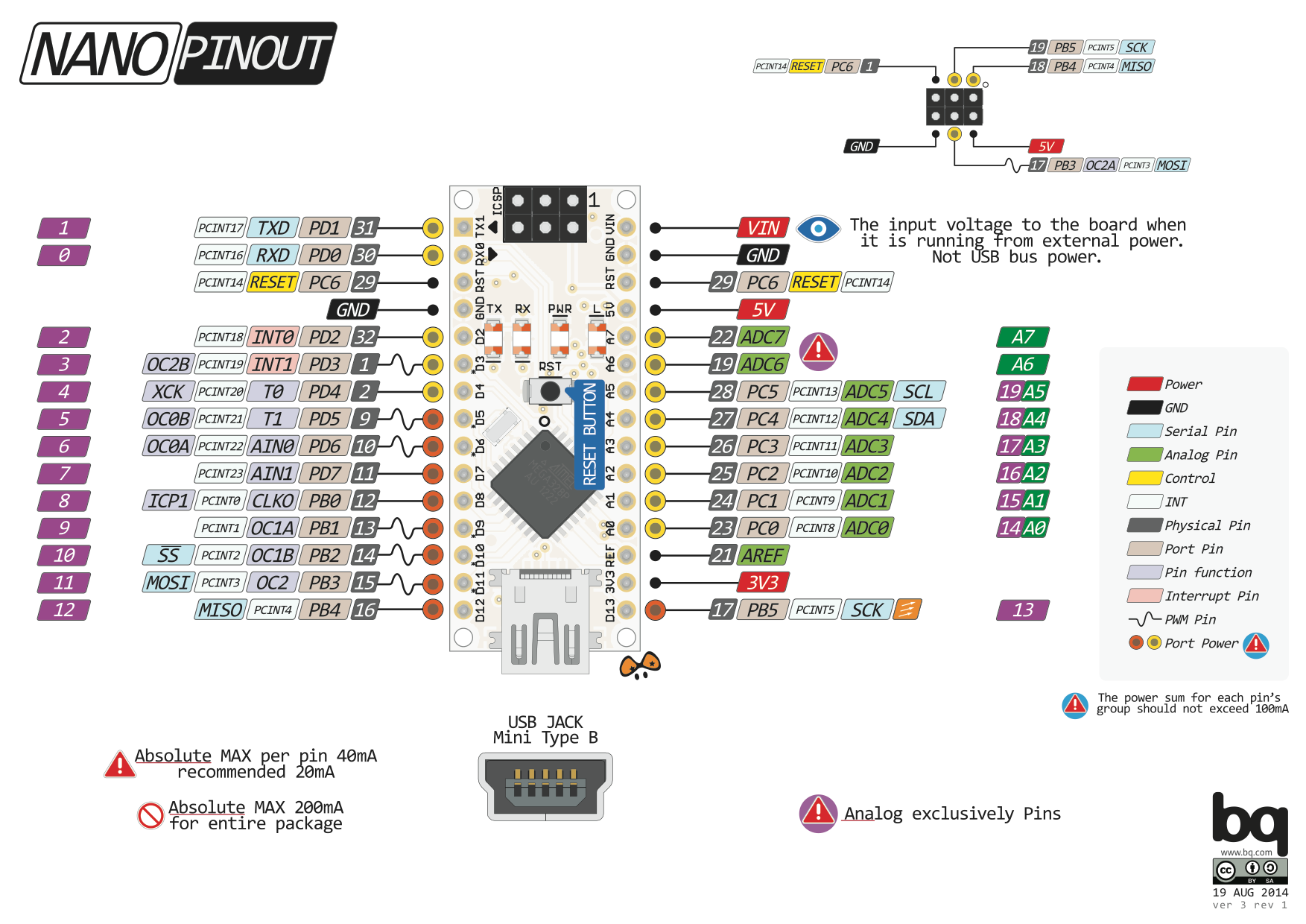Arduino Nano on:
[Wikipedia]
[Google]
[Amazon]
The Arduino Nano is a small, complete, and breadboard-friendly
 *
*
Nano webpage
*
Nano schematic
Arduino
board
Board or Boards may refer to:
Flat surface
* Lumber, or other rigid material, milled or sawn flat
** Plank (wood)
** Cutting board
** Sounding board, of a musical instrument
* Cardboard (paper product)
* Paperboard
* Fiberboard
** Hardboard, a ty ...
based on the ATmega328P released in 2008. It offers the same connectivity and specs of the Arduino Uno board in a smaller form factor.
The Arduino Nano is equipped with 30 male I/O headers, in a DIP-30-like configuration, which can be programmed using the Arduino Software integrated development environment (IDE), which is common to all Arduino boards and running both online and offline. The board can be powered through a type-B mini-USB cable or from a 9 V battery.
History
The Arduino Nano was released in 2008. In 2019, Arduino released the Arduino Nano Every, a pin-equivalent evolution of the Nano. It features a more powerful ATmega4809 processor and twice the RAM.Technical specifications
 *
* Microcontroller
A microcontroller (MCU for ''microcontroller unit'', often also MC, UC, or μC) is a small computer on a single VLSI integrated circuit (IC) chip. A microcontroller contains one or more CPUs (processor cores) along with memory and programmable i ...
: Microchip ATmega328P
* Operating voltage: 5 volts
* Input voltage: 5 to 20 volts
* Digital I/O pins: 14 (6 optional PWM outputs)
* Analog input pins: 8
* DC per I/O pin: 40 mA
* DC for 3.3 V pin: 50 mA
* Flash memory
Flash memory is an electronic non-volatile computer memory storage medium that can be electrically erased and reprogrammed. The two main types of flash memory, NOR flash and NAND flash, are named for the NOR and NAND logic gates. Both us ...
: 32 KB, of which 2 KB is used by bootloader
* SRAM: 2 KB
* EEPROM
EEPROM (also called E2PROM) stands for electrically erasable programmable read-only memory and is a type of non-volatile memory used in computers, usually integrated in microcontrollers such as smart cards and remote keyless systems, or as a ...
: 1 KB
* Clock speed: 16 MHz
* Length: 45 mm
* Width: 18 mm
* Mass: 7 g
* USB: Mini-USB Type-B
* ICSP Header: Yes
* DC Power Jack: No
Communication
The Arduino Nano has a number of facilities for communicating with a computer, another Arduino, or other microcontrollers. The ATmega328 provides UART TTL (5V) serial communication, which is available on digital pins 0 (RX) and 1 (TX). An FTDI FT232RL on the board channels this serial communication over USB and the FTDI drivers (included with the Arduino firmware) provide a virtual com port to software on the computer. The Arduino software includes a serial monitor which allows simple textual data to be sent to and from the Arduino board. The RX and TX LEDs on the board flash when data is being transmitted via the FTDI chip and the USB connection to the computer (but not for serial communication on pins 0 and 1). A SoftwareSerial library allows for serial communication on any of the Nano's digital pins. The ATmega328 also supports I2C and SPI communication. The Arduino software includes the Wire library to simplify use of the I2C bus.Automatic (software) reset
Rather than requiring a physical press of the reset button before an upload, the Arduino Nano is designed in a way that allows it to be reset by software running on a connected computer. One of the hardware flow control lines (DTR) of the FT232RL is connected to the reset line of the ATmega328 via a 100 nanofarad capacitor. When this line is asserted (taken low), the reset line drops long enough to reset the chip. This setup has other implications. When the Nano is connected to a computer running Mac OS X or Linux, it resets each time a connection is made to it from software (via USB). For the following half-second or so, the bootloader is running on the Nano. While it is programmed to ignore malformed data (i.e. anything besides an upload of new code), it will intercept the first few bytes of data sent to the board after a connection is opened.See also
*AVR microcontrollers
AVR is a family of microcontrollers developed since 1996 by Atmel, acquired by Microchip Technology in 2016. These are modified Harvard architecture 8-bit RISC single-chip microcontrollers. AVR was one of the first microcontroller families to u ...
* Atmel AVR instruction set
* In-system programming
References
Further reading
External links
{{Commons category, Arduino NanoNano webpage
*
Nano schematic
Arduino